
A new wind blowing across the sporting rifle landscape is delivering a dominating combination of affordability and accuracy — the rise of the fat-bolt rifle.
What are the fat-bolt rifle's benefits compared to traditional twin-lug bolt guns?
- Bolt thrust or axial forces are more evenly distributed to three points than two.
- Components require less machining, so tolerances between bolt and raceway can be much closer.
- Tri-lug actions require only 60 or so degrees of bolt rotation.
- This makes them faster to operate than standard 90-degree dual-lug actions.
- Most fat-bolt rifles are less expensive than standard dual-lug bolt actions.
Unless you’ve been living on another planet, you probably know that the age of the twin lug '98 Mauser-type bolt-action rifle is history. Now, there is no question that the twin-lug action has had a helluva run these past 120 years — we’ve only to look at the popularity of the Remington 700, Savage 100 series, Winchester Model 70, Ruger M77 or Mossberg Patriot to prove it.
But if starting with a clean sheet of paper, I’m saying that no established or start-up rifle manufacturer is likely to come out with a Mauser-type action because there are simply better and more efficient ways to produce a rifle. As always, there are and will be exceptions — Barrett’s recent introduction of its Fieldcraft rifle is a good example, it being a Remington 700 clone. But like I said, generally speaking, the days of the twin-lug action are over when it comes to new rifle introductions.

So what growing trend is it that’s relegating the twin-lug bolt action to the dustbin of history? That’s easy; it’s the tri-lug full-diameter action as exemplified by the Ruger American and Winchester XPR, to name just two of a growing family of turnbolts sharing the same basic design characteristic.
I believe it was me who coined the term “fat bolt” in an article I wrote nearly 50 years ago describing the Weatherby Mark V Magnum, for it was Weatherby who, in 1957, introduced the concept. In a nutshell, the defining characteristic of the fat-bolt tri-lug action is a bolt body that’s large enough in diameter that the three (or multiples of three) locking lugs oriented on 120-degree centers can be formed by removing metal at the head of the bolt.
In other words, the locking lugs do not protrude beyond the outside diameter of the bolt body behind. There can be three rows of three, as in the case of the nine-lug Weatherby, two rows of three, as in the case of the six-lug Sauer 202 and Roessler Titan 6, or just a single row of three lugs as employed by the Ruger American and Winchester XPR. In every case, the lugs are of less depth than on a twin-lug action, but the shear surfaces are greater.
In addition to the five rifles already mentioned — the Browning A-Bolt III, Thompson/Center’s Venture and Dimension, the German Sauer 100 and Steyr SM-12, the Austrian Roessler Titan 3 and 6, and the Australian Lithgow — all comprise the 13-member fat-bolt tri-lug family. And I may have missed a few.
Having no protruding locking lugs for which raceways must be broached or otherwise machined into the inner walls of the receiver, only a round hole is needed to accommodate the bolt. Inherent, however, in all fat-bolt actions is that the bolt stop/release also serves as the bolt guide by engaging a lengthwise slot on the left side of the bolt body.
Without this arrangement, if the bolt stop is disengaged and the bolt out of battery, it would be free to rotate 360 degrees if it were not for the bolt handle hitting either side of the stock. It’s an academic point but one that one must be aware of.
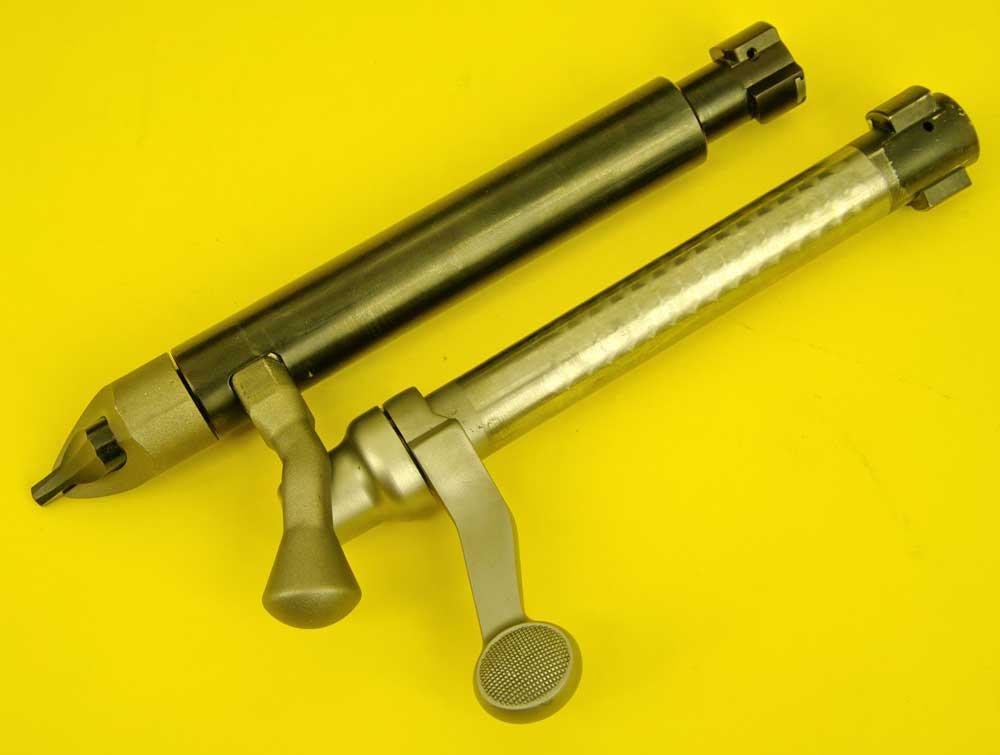
Machining Efficiency
Well, for one thing, bolt thrust or axial forces are more evenly distributed to three points than two; it better ensures a bolt face that’s square with the barrel bore. Also, there’s less machining of the components required, so the tolerances between the bolt and its raceway within the receiver can be much closer than for a twin-lug action with protruding locking lugs. This translates into smoother bolt glide and less lateral play in the bolt when fully withdrawn against the bolt stop.
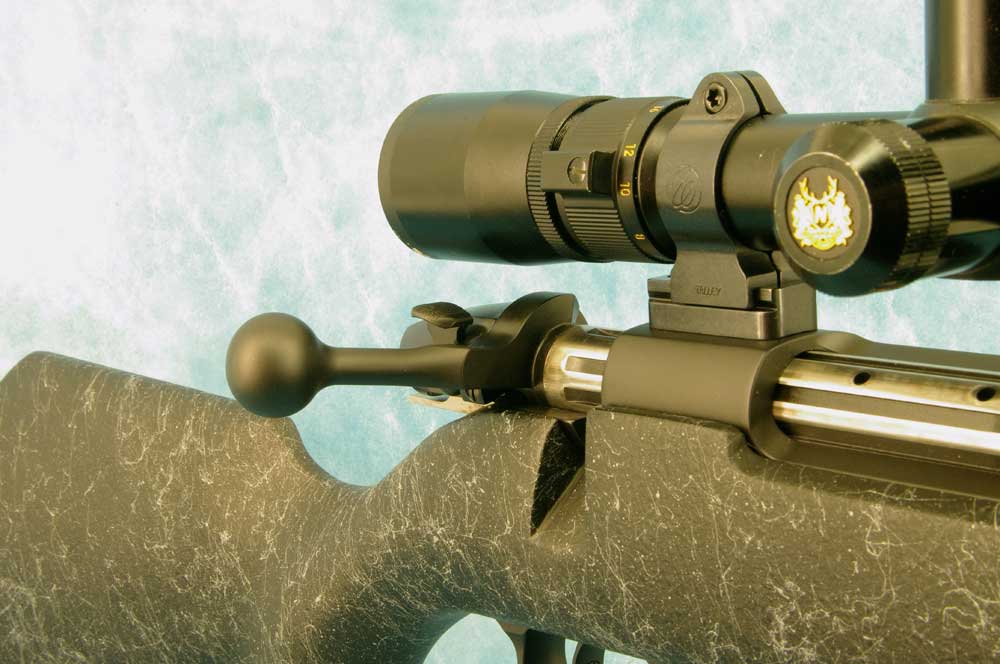
Quick Operation
All tri-lug actions require only 60 or so degrees of bolt rotation (handle lift), as opposed to a twin-lug action which requires 90, so another advantage of falt-bolt rifles is that they are faster to cycle for a follow-up shot, and there’s more clearance for the hand as it slides past the scope’s ocular bell.
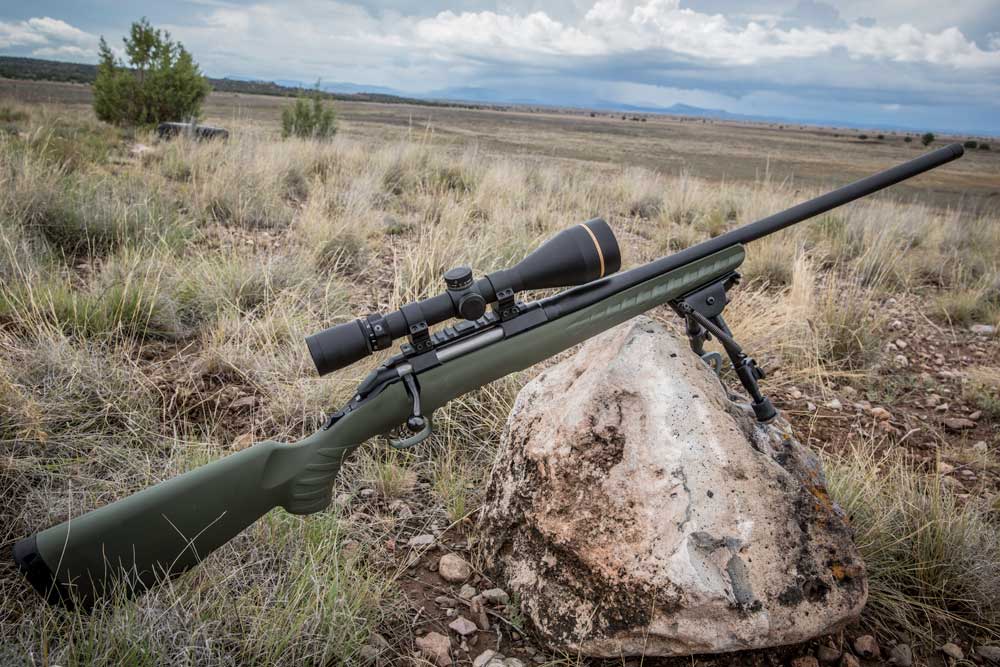
Minimized Price Tag
Bottom line: When mated to inexpensive injection-molded stocks, the typical fat-bolt rifle like the Ruger American and Winchester XPR can be produced for far less than their pricier siblings, the Hawkeye and the Model 70, respectively.
How much less? Consider: The Ruger M77 Hawkeye Standard rifle has an MSRP of $979, while the American goes for $489! The Model 70 Sporter commands $1,049, while the XPR can be had for $549! I use Ruger and Winchester here as examples because they are the most typical and familiar manifestations of the fat-bolt genre in the American marketplace, but in all other cases the same price disparity exists if a given rifle maker has two distinct lines.
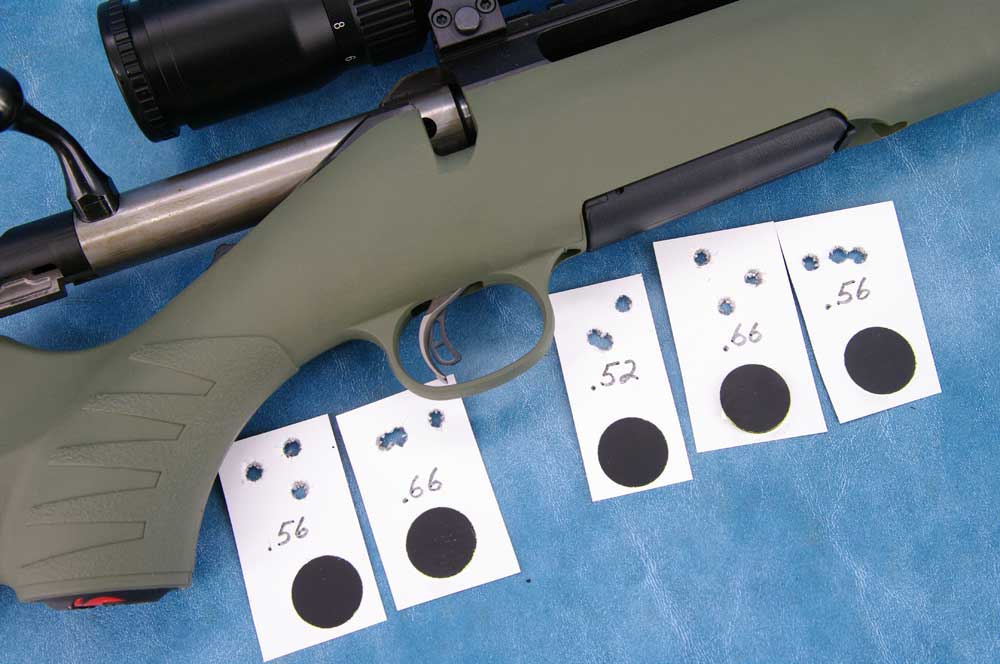
Affordable Accuracy
But there’s an even better aspect than the affordability of these guns, and it’s that they’re easily as accurate as their more expensive siblings, and in my experience having tested dozens of them, even more so. The only compromises are those of aesthetics. The degree of machining and polish on these $500 guns is a mite less than on rifles costing twice as much, but the growing number of owners obviously could not care less. Ditto for the injection-molded stock, which can be just as elegant of line and dimension as the most classic masterpiece handcrafted in French walnut.
The current Remington Model 700 SPS is a perfect example. Replace the existing rubberized grip panels with a classic checkering pattern (molded of course), and you have a stock that visually can rival that of any custom stockmaker. The only compromise is a tactile one: These stocks do lack the warmth and solid feel of real wood, but again, it’s a compromise value-conscious owners are more than willing to accept.
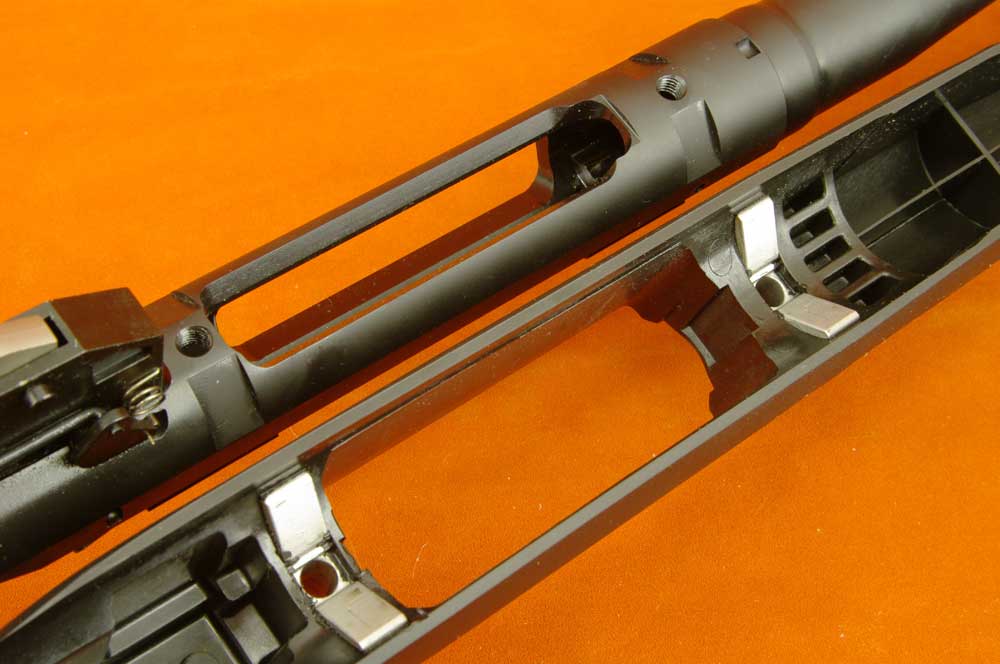
Impeccable Bedding Consistency
One advantage the injection-molded stock brings to the table is one of bedding consistency. Every stock is exactly like every other dimensionally, and in high-volume production, manufacturing tolerances can be held at much higher standards than with wood. Whatever bedding dynamic a manufacturer chooses to employ — pillar, partial or full barrel float, tip pressure, V-block … whatever — every stock is exactly the same.
One of the most innovative bedding systems is found in the Ruger American, where two massive steel V-Blocks are embedded into the stock fore and aft of the magazine mortise to cradle and center the receiver. What’s more, these V-blocks engage grooves milled into the underside of the receiver to double as recoil shoulders. It’s a system that guarantees a perfectly consistent bedding dynamic.
As to how well this system works, I recently tested a Ruger American Predator chambered in the new 6mm Creedmoor that, with factory ammunition, proved to be one of the most accurate sporter-weight rifles I’ve ever tested. Three-shot 100-yard groups with Hornady’s 108-grain ELD Match ammo were incredibly consistent, ranging from .52 to .66 inch, with a five-group average of .59 inch!
More simple variations of the Ruger’s “Power Bedding” as they call it, can be found in T/C’s Venture, the Finnish Tikka and Winchester’s XPR. All employ a steel plate embedded in the stock to mate with a groove on the underside of the receiver ring. It does the job of transferring recoil forces to the stock as well as any other system, and it’s far easier to produce than having a separate washer-type recoil plate a la Remington 700 and the like, or a receiver with an integral lug like on the Winchester Model 70.

Magazine Evolution
Another trend we’re seeing is the ascendency of the detachable magazine over the traditional fixed box with hinged floorplate. What has evolved is the virtual one-piece polycarbonate magazine which weighs less than half of a sheet metal version; it can’t rust, it’s virtually indestructible, it has integral feed lips which can’t be bent, and a natural lubricity that makes cartridge feeding incredibly smooth and effortless. Tri-lug rifles have no monopoly on this trend, as there are many excellent examples out there, tri-lugs or otherwise.
The perennial gripes against a detachable magazine is that they can be lost, or due to heavy recoil, release and drop out of a rifle at the most inopportune time — like when you’re being charged by a wounded Cape buffalo! Over the course of my 50 years as a gun writer, I’ve encountered only one big-bore rifle whose floorplate opened during testing.
Today’s detachable magazines are designed so that inadvertent release is virtually impossible. And for sheer convenience, a detachable magazine makes it so much faster and convenient to empty. I swear that with a hinged floorplate, at least one cartridge will likely fall to the ground every time you try to empty the box with one hand. And with a blind magazine, each cartridge must be partially cycled to unload, which is a real pain when you’re hunting out of a vehicle and where the law requires the chamber and magazine be vacant.
A Lot More, For Far Less
As I see it, there’s no question but that there’s a new wind blowing across the sporting rifle landscape — a wind that brings better, more advanced designs, a higher level of accuracy, and at prices within reach of more hunters and shooters than ever before.
How can that be bad?
Editor's Note: This article is an excerpt from the Winter 2017 issue of Gun Digest the Magazine.

Next Step: Get your FREE Printable Target Pack
Enhance your shooting precision with our 62 MOA Targets, perfect for rifles and handguns. Crafted in collaboration with Storm Tactical for accuracy and versatility.
Subscribe to the Gun Digest email newsletter and get your downloadable target pack sent straight to your inbox. Stay updated with the latest firearms info in the industry.

![Best Concealed Carry Guns In 2025 [Field Tested] Wilson Combat EDC X9S 1](https://gundigest.com/wp-content/uploads/Wilson-Combat-EDC-X9S-1-324x160.jpg)


![Best 9mm Carbine: Affordable PCCs [Tested] Ruger Carbine Shooting](https://gundigest.com/wp-content/uploads/Ruger-Carbine-Shooting-100x70.jpg)
![Best AR-15: Top Options Available Today [Field Tested] Harrington and Richardson PSA XM177E2 feature](https://gundigest.com/wp-content/uploads/Harrington-and-Richardson-PSA-XM177E2-feature-100x70.jpg)

I collect and use Wichita bolt actions. They are fine “fat bolt” designs but, as bhp0 has pointed out, bolt lift inevitably requires more force. After they’ve slicked up enough, they are quite usable. But then I’ll handle a well-worn old Mauser and the buttery smoothness of the bolt lift never ceases to amaze me. The smoothest bolt action I have is a two-lug Remington XP that’s so smooth simply because of all the thousands of times it’s been cycled. My favorite Wichita comes close but will never equal it.
At the very top end of custom rifles or bolt pistols, I don’t think it really matters. Both types of actions can be smooth enough to not be an impediment to their use for their intended purposes. But if you just take a sensual joy in a bolt that lifts like a hot knife through butter, the fat bolt is not the way to go.
I HEAR THIS BS FROM TIME TO TIME! IF YOU WANT A COOKIE CUTTER RIFLE THAT IS YOUR CHOICE BUT! IF YOU THINK THE 98 MAUSER IS HISTORY YOU KNOW NOTHING ABOUT THE FEEL THE LOOK OR THE DEPENDABILITY OR ACCURACY OF THE 98 MAUSER! YOU GUYS ARE THE SAME PEOPLE THAT RELY ON I-PHONES FACE BOOK FROZEN FOOD AND BELIEVE EVERY THING YOU READ ON THE COMPUTER! I LOOK AT THIS CRAP THAT IS BUILT TODAY AND THEY ALL LOOK ALIKE. I AGREE WITH THE GENTLEMAN THAT TALKED ABOUT ACCURACY. ( THANK YOU! ) LET THEM BUY THE PLASTIC GUNS BUILT TODAY AND THEIR FACTORY AMMO. SHAME! KIND OF LIKE BUILDING A BETTER MOUSE TRAP. I GUESS WE SHOULD ALL MAKE TOMATO STAKES OUT OF OUR BEAUTIFUL OUT DATED WOOD STOCKED NON ACCURATE MAUSERS! WHEN PIGS FLY! KEVIN MANLEY
Schultz & Larsen have been making rifles with a three lug bolt for many years. Not only that but they use a switch barrel system with the bolt locking into the barrel itself & their barrels are cut rifled then tin lapped, so about as stress free as it’s possible to make.
They’re also extremely accurate, with 0.5MOA being the norm & all from a relatively inexpensive rifle.
Oh & their scope mounting system is superb too.
quote——————————Bolt thrust or axial forces are more evenly distributed to three points than two.
Components require less machining, so tolerances between bolt and raceway can be much closer.
German Mauser 98 Actions made long ago had much closer tolerances all one has to do is look at their standards compared to modern day rifles. Its no contest. Few modern day actions are even “squared off ” at the barrel junction to the action which is a leading cause of flyers.
Quote——————————–Tri-lug actions require only 60 or so degrees of bolt rotation.
This makes them faster to operate than standard 90-degree dual-lug actions.—————–Quote—————-
100 per cent wrong. The bolt lift on a 90 degree action such as found in the Mauser 98 Winchester 70 or Remington 700 is much easier to lift and operate rapidly than the very stiff bolt life of multi-lug bolt action rifles because they not only slow down bolt operating time but are more inclined to throw ones aim off as well when holding the rifle in the off hand position and trying to rapidly manipulate the stiff bolt throw for a second shot. They suck big time.
quote—————–Most fat-bolt rifles are less expensive than standard dual-lug bolt actions.———————–quote——————————–
It depends on which rifles we are comparing them too. If we are comparing new rifles to new rifles yes sometimes but new rifles to old rifles not true all the time as there are still real deals on older high quality used Mauser 98 rifles and older American made rifles as well.
What makes the fat bolt guns cheaper is one of cost which means”lets build it cheaper and lets build it faster” because today shooters will not know the difference or if they do not be able to afford an old fashioned high quality new rifle, one with a gorgeous walnut stock and one with “real hand checkering” not modern junk machine cut checkering which is an insult to one who knows what a high quality gun is supposed to be.
New guns have junk cast steel receivers much of the time and junk cast internal parts none of which hold up like good forged old fashioned heat treated parts.
And then there is the butt ugly plasticky stocks and even trigger guards and floor plates and even followers. Guaranteed to make you throw up all over your shoes just looking at such garbage. Many rifle companies use the bottom of the line plasticky stocks that are injection molded resulting in a stock so flimsy one fellow who bought a single shot rifle with a two piece stock was able to shake the rifle by the butt stock and see the junk plasticky stock actually sway back and forth. He threw the damn piece of junk right into the trash and ordered a wood stock for his gun. At least he could live with that.
Earlier M70 Winchester stocks which had no bedding blocks often mushroomed out when the actions screws were tightened down. Pure garbage. Plus plasticky stocks are slick to try and hold on too in the rain and they are cold as ice in the winter as compared to wooden stocks. Budget priced plasticky stocks which factories usually use can also cause point of impact shift because they do indeed swell up or down according to the temperature the exact same criticism often leveled at wood stocks but at least with a wood stock you can often weatherize it by coating the inside with stock finish. You cannot cure the ills of a cheap junk injection molded plasticky stock.
In conclusion screw the gun industry today as I have always bought older quality made rifles and often at give away prices. I have often even had them rebuilt for less money than some of the newer priced guns. Its just that you have to find a professional small time local gun smith that does not rip you off and believe it or not yes they still do exist. I had a WWI sportsitized Mauser re-barrled after its 22-250 barrel burned up. I bought it this way for only $250 and had it re-barreled and I accurized the gun with a good glass bedding job, timney trigger I had sitting in the basement for years I bought for almost nothing at a gun show and I floated the new Shilen barrel and it out shot some of my more prestigious modern factory guns that often have mass produced junk barrels proving what outstanding workmanship went into old fashioned M98 Mauser guns. I ended up with a little over $600 in it complete with its original beautiful hand checkered walnut stock. The younger boys with their modern plastiky trash drool over it every time I bring it out to show them or have it at the range.
By the way my 3 shot cheater groups out perform the above 3 shot cheater groups in the above picture and my 5 shot groups look more like the above 3 shot cheater pictures groups. Notice the author did not show you any 5 shot groups. That is a dead giveaway as to the real accuracy of the above new fat bolt factory barreled guns i.e. they are junk as they would not have cut the mustard if 5 shot groups would have been shown to you.
I lament the passing of the huge Mauser extractor and the leverage it can apply to a stubborn case, but I understand the economic reasoning. The 1899 Savage and 1895 Winchester are no longer with us for similar reasons. However, I have misgivings regarding those polycarbonate magazines and injection molded plastic stocks. Plastics, no matter what additives or coatings are applied, eventually degrade and become brittle with exposure to ultraviolet radiation and atmospheric oxygen. I find myself wondering if these guns will have useful lifespans even approaching those of their obsolescent wood and all steel counterparts.
Wood eventually degrades and cracks, usually faster than plastic.
Since the magazine is removable, it is replaceable.